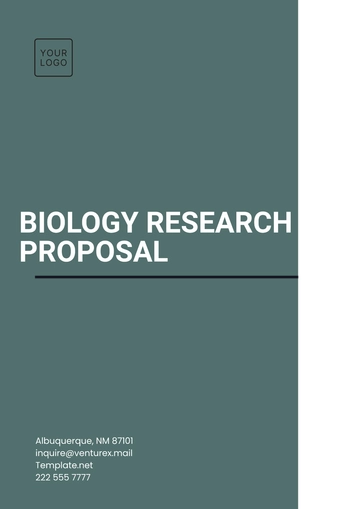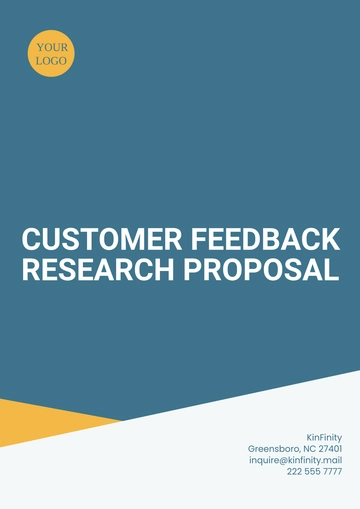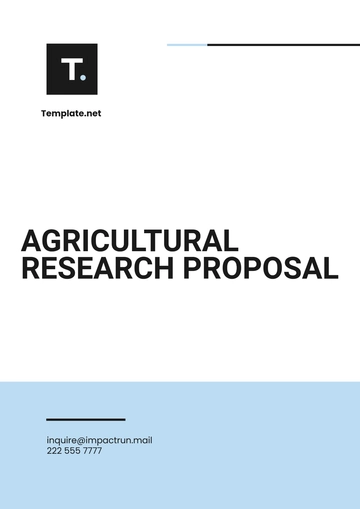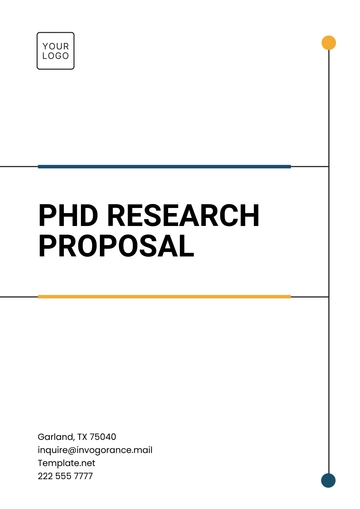Free Pharmaceutical Research Proposal

Prepared By: [Your Name]
Abstract
This research proposal aims to tackle the critical global health crisis caused by the rise of multi-drug resistant (MDR) bacterial infections through the creation of new antibiotic treatments, as the increasing occurrence of MDR bacteria has significantly diminished the effectiveness of current antibiotics, resulting in higher rates of illness, death, and healthcare expenses. The proposal presents a detailed plan for discovering, creating, and testing new antibiotic candidates to combat MDR bacterial strains, aiming to develop successful therapeutic solutions.
I. Introduction
The rise of antibiotic-resistant bacterial strains poses a significant threat to modern healthcare, leading to extended illnesses, higher death rates, and rising medical costs; this study seeks to discover and create new antibiotics that can overcome these resistance mechanisms and offer a vital solution.
II. Background and Rationale
The urgent increase in multidrug-resistant bacteria, along with the declining efficacy of existing antibiotics, highlights the necessity for new therapeutic strategies. Progress in medicinal chemistry, molecular biology, and computational drug design presents promising prospects for creating new, more effective antibiotics. This research utilizes these advancements to develop novel compounds with strong antibacterial properties against multidrug-resistant strains, thereby filling a crucial void in available treatments.
III. Research Objectives
Identification of Lead Compounds: Conduct high-throughput screening of diverse chemical libraries to identify compounds with promising antibacterial activity.
Synthesis of Novel Derivatives: Design and synthesize novel compounds based on the identified lead structures, optimizing their antibacterial properties.
In Vitro Evaluation: Assess the antibacterial efficacy of the synthesized compounds against a broad spectrum of clinically relevant MDR bacterial strains.
Mechanism of Action Studies: Elucidate the mechanisms by which the most potent compounds exert their antibacterial effects, and investigate potential resistance pathways.
IV. Methodology
1. High-Throughput Screening
We will utilize automated high-throughput screening (HTS) technology to analyze large chemical libraries for compounds that inhibit bacterial growth. The screening will focus on MDR strains of Staphylococcus aureus, Escherichia coli, and Pseudomonas aeruginosa. Lead compounds that demonstrate significant antibacterial activity will be prioritized for further development.
2. Chemical Synthesis
Selected lead compounds will undergo structural optimization through chemical modifications aimed at enhancing their antibacterial potency, stability, and selectivity. Standard organic synthesis techniques will be employed, including functional group modifications, scaffold hopping, and stereochemical alterations. The synthesized derivatives will be characterized using techniques such as NMR, mass spectrometry, and X-ray crystallography.
3. In Vitro Antibacterial Testing
The synthesized compounds will be tested against a panel of clinically relevant MDR bacterial strains, including Staphylococcus aureus, Escherichia coli, and Pseudomonas aeruginosa. Minimum inhibitory concentrations (MICs) will be determined using broth microdilution methods, allowing for the quantification of each compound's antibacterial efficacy.
Bacterial Strain | MIC Determination Method |
|---|---|
Staphylococcus aureus | Broth Microdilution |
Escherichia coli | Broth Microdilution |
Pseudomonas aeruginosa | Broth Microdilution |
4. Mechanism of Action Studies
For the most potent compounds, we will conduct detailed mechanism of action studies using a combination of techniques, including bacterial membrane integrity assays, enzyme inhibition assays, and genetic mutational analysis. These studies will provide insights into the molecular interactions between the compounds and their bacterial targets, as well as potential resistance mechanisms.
V. Expected Outcomes
Identification of novel chemical entities with robust antibacterial activity against MDR bacteria.
Successful synthesis and optimization of novel compounds with enhanced antibacterial efficacy.
Comprehensive understanding of the mechanisms of action and potential resistance pathways for the most promising compounds.
Contribution to the global effort to combat antibiotic resistance by providing new therapeutic options.
VI. Conclusion
This research proposal outlines a forward-thinking and strategic plan to tackle the growing danger of multi-drug resistant (MDR) bacterial infections by discovering and creating new antibiotics. The project's goal is to offer new, effective treatments for fighting MDR bacteria, significantly benefiting global public health. Achieving success in this research could revolutionize antibiotic development and greatly decrease the impact of antibiotic-resistant infections.
VII. References
Centers for Disease Control and Prevention. (2021). Antibiotic Resistance Threats in the United States, 2019. Retrieved from https://www.cdc.gov/drugresistance/pdf/threats-report/2019-ar-threats-report-508.pdf
World Health Organization. (2020). Antibacterial agents in clinical development: an analysis of the antibacterial clinical development pipeline. Retrieved from https://www.who.int/publications/i/item/9789240000193
Murray, C. J. L., Ikuta, K. S., Sharara, F., Swetschinski, L., Robles Aguilar, G., Gray, A., ... & Naghavi, M. (2022). Global burden of bacterial antimicrobial resistance in 2019: a systematic analysis. The Lancet, 399(10325), 629-655. doi:10.1016/S0140-6736(21)02724-0
- 100% Customizable, free editor
- Access 1 Million+ Templates, photo’s & graphics
- Download or share as a template
- Click and replace photos, graphics, text, backgrounds
- Resize, crop, AI write & more
- Access advanced editor
Craft thorough and compelling proposals with Template.net's Pharmaceutical Research Proposal Template. This editable and customizable template provides a framework for structuring your research objectives, methodologies, and expected results. Editable in our AI Editor Tool, it ensures your pharmaceutical research proposal is detailed and well-organized, helping to secure the support needed for developing innovative and effective pharmaceutical solutions.
You may also like
- Business Proposal
- Research Proposal
- Proposal Request
- Project Proposal
- Grant Proposal
- Photography Proposal
- Job Proposal
- Budget Proposal
- Marketing Proposal
- Branding Proposal
- Advertising Proposal
- Sales Proposal
- Startup Proposal
- Event Proposal
- Creative Proposal
- Restaurant Proposal
- Blank Proposal
- One Page Proposal
- Proposal Report
- IT Proposal
- Non Profit Proposal
- Training Proposal
- Construction Proposal
- School Proposal
- Cleaning Proposal
- Contract Proposal
- HR Proposal
- Travel Agency Proposal
- Small Business Proposal
- Investment Proposal
- Bid Proposal
- Retail Business Proposal
- Sponsorship Proposal
- Academic Proposal
- Partnership Proposal
- Work Proposal
- Agency Proposal
- University Proposal
- Accounting Proposal
- Real Estate Proposal
- Hotel Proposal
- Product Proposal
- Advertising Agency Proposal
- Development Proposal
- Loan Proposal
- Website Proposal
- Nursing Home Proposal
- Financial Proposal
- Salon Proposal
- Freelancer Proposal
- Funding Proposal
- Work from Home Proposal
- Company Proposal
- Consulting Proposal
- Educational Proposal
- Construction Bid Proposal
- Interior Design Proposal
- New Product Proposal
- Sports Proposal
- Corporate Proposal
- Food Proposal
- Property Proposal
- Maintenance Proposal
- Purchase Proposal
- Rental Proposal
- Recruitment Proposal
- Social Media Proposal
- Travel Proposal
- Trip Proposal
- Software Proposal
- Conference Proposal
- Graphic Design Proposal
- Law Firm Proposal
- Medical Proposal
- Music Proposal
- Pricing Proposal
- SEO Proposal
- Strategy Proposal
- Technical Proposal
- Coaching Proposal
- Ecommerce Proposal
- Fundraising Proposal
- Landscaping Proposal
- Charity Proposal
- Contractor Proposal
- Exhibition Proposal
- Art Proposal
- Mobile Proposal
- Equipment Proposal
- Student Proposal
- Engineering Proposal
- Business Proposal





























